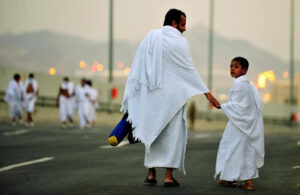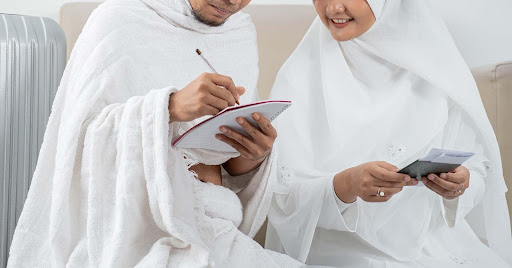The Hajj pilgrimage is a once-in-a-lifetime spiritual journey that requires meticulous planning and preparation. Whether you’re a first-timer or have performed Hajj before, this article will guide you through every step of the Hajj preparations, from obtaining travel documents to learning the sacred rituals.
You’ll discover essential tips for packing and making the most of your journey to Mecca, ensuring that you’re fully prepared for this life-changing experience.
Who is allowed to go on the Hajj?

In Islam, Hajj is a pilgrimage that is mandatory for all physically and financially able adult Muslims to perform at least once in their lifetime.
Therefore, any Muslim who has reached the age of puberty is mentally and physically capable and has enough financial resources to make the journey to Mecca can perform Hajj. However, if someone is unable to perform Hajj due to health or financial reasons, they are exempted from performing this obligation.
Hajj preparations 2023
Hajj preparations can be a life-changing experience and require careful planning and enough knowledge. Here are some steps that can help you prepare:
1. Learn about Hajj rituals
The pilgrimage consists of a series of rituals that are performed over five to six days in and around the holy city of Mecca, Saudi Arabia.
Understanding the meaning and significance of each ritual is crucial for Hajj preparations as it helps to deepen one’s spirituality and strengthen their connection with Allah. The different rituals of Hajj include:
- Ihram:
This is the act of wearing a simple white garment (two-piece seamless cloth) that represents purity and equality. It symbolizes the idea that everyone is equal before Allah S.W.T regardless of their status, wealth, or nationality.
- Tawaf:
This involves walking seven times around the Kaaba in an anti-clockwise direction while reciting prayers. It symbolizes the unity of Muslims worldwide, as they come together to worship Allah.
- Sa’i:
This involves walking seven times between the hills of Safa and Marwa, which represents the struggle of Hagar, the wife of Prophet Ibrahim, in search of water for her son Ismail. It symbolizes the importance of perseverance and reliance on Allah in times of difficulty.
- Wuquf Arafat:
This is the main ritual of Hajj and involves standing in the plain of Arafat from noon until sunset, seeking forgiveness and repentance from Allah. It symbolizes the Day of Judgment when people will stand before Allah and be held accountable for their deeds.
- Muzdalifah:
This involves spending the night in an open area and collecting pebbles for the next ritual.
- Stoning of the Devil:
This involves throwing pebbles at three pillars that represent Satan’s temptation of Prophet Ibrahim to disobey God’s command to sacrifice his son Ismail. It symbolizes the rejection of evil and a commitment to following God’s commands.
- Sacrifice:
This involves sacrificing an animal, usually a sheep or goat, as an act of submission and gratitude to Allah. The meat is then distributed among the poor and needy, symbolizing generosity and compassion.
- Tawaf al-Ifadah and Sa’i:
This involves repeating the Tawaf and Sa’i rituals, which were performed earlier in Hajj.
- Tawaf al-Wida:
This is the final ritual of Hajj and involves performing Tawaf around the Kaaba before leaving Mecca. It symbolizes bidding farewell to the holy city and ending the pilgrimage with a renewed sense of faith and more worship.
2. Get vaccinated and obtain the necessary medical clearance
Those planning to perform Hajj should prioritize their health and safety. Vaccinations against common illnesses such as meningitis, yellow fever, influenza, and pneumonia are crucial due to the large gatherings of pilgrims from all over the world.
Pilgrims should also follow recommended health precautions as a crucial step of Hajj preparations like practicing good hygiene, avoiding crowded areas, and staying hydrated. Also, medical clearance is necessary, and the process varies by country.
It involves visiting a healthcare provider who will assess one’s health status and provide any needed vaccinations or medications. In some countries, medical clearance is required before a visa can be issued.
3. Apply for a Hajj visa and make travel arrangements
The process of applying for a Hajj visa requires certain documents, including:
- a valid passport.
- Proof of vaccination.
- a letter of recommendation from a local mosque.
- checking the requirements of the country you’re traveling from and the regulations of the Saudi Arabian government. To make the journey more manageable.
It is also recommended to book a Hajj package through a reliable travel agency that provides accommodation options and support during the pilgrimage.
4. Gather necessary documents and supplies
When preparing for the Hajj pilgrimage, it is important to gather all the necessary documents and supplies that will be needed during the trip. This includes both essential documents and personal belongings that will make the journey more comfortable.
In addition to the necessary documents, several supplies are recommended for the Hajj preparations:
- Comfortable and modest clothing that is appropriate for the climate and culture.
- Comfortable shoes for walking long distances.
- Toiletries such as toothbrush, toothpaste, soap, shampoo, and towels.
- Umbrella or hat for sun protection.
- Medications and first aid kit.
- Portable phone charger.
- Snacks and water bottles.
- Money belt or safe for storing valuables.
5. Learn a few basic Arabic phrases
It is recommended to learn some basic Arabic phrases that can be helpful during your stay in Saudi Arabia. This will not only enhance your experience but also facilitate communication with the locals and fellow pilgrims. Therefore, take some time to familiarize yourself with common Arabic expressions such as greetings, asking for directions, ordering food, and expressing gratitude. By doing so, you will be better prepared to navigate through the holy cities and connect with the people and culture around you.

6. Prepare spiritually and mentally for Hajj
Hajj preparations involve both spiritual and mental readiness:
- Spiritually:
It is important to purify one’s intentions and seek forgiveness for past mistakes, as well as read and reflect on the Quran to deepen one’s faith.
- Mentally:
It is important to prepare for the physical demands of the journey by maintaining good health and fitness, as well as studying the rituals and logistics of the Hajj to be fully informed and prepared. This can involve attending Hajj orientation sessions and consulting with experienced Hajj guides and mentors.
Additionally, it is important to prepare oneself emotionally for the intense spiritual experience that awaits during the Hajj. This can involve setting personal goals for the pilgrimage and mentally preparing oneself to stay focused and present throughout the journey.
Also, spiritual and mental Hajj preparations require dedication, discipline, and a sincere desire to connect with God and fulfill one’s religious obligations.
Remember, Hajj is a journey of a lifetime, and proper Hajj preparations can make your experience more meaningful and rewarding.









